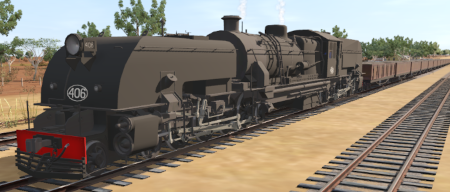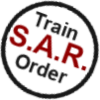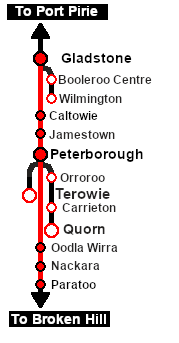SAR Scenario Gladstone Bulk Ore
m |
|||
| Line 22: | Line 22: | ||
The line from '''Port Pirie''' to '''Cockburn''' on the '''South Australia - New South Wales''' border was built in stages from 1875 to 1888 largely to capture the lead, zinc and silver ore traffic from the mines at '''Broken Hill''' just over the border in '''New South Wales'''. Because the '''SAR''' was not allowed to operate into '''New South Wales''', a private railway, the '''Silverton Tramway''', was created to carry the ore across the border. The '''SAR''' and '''Silverton Tramway''' simply swapped locos at '''Cockburn''' on the border. It was called a "tramway" to get around a NSW law banning private railways but not private tramways. Despite the title it was a fully operating heavy haul railway, and one of the most profitable in the country. | The line from '''Port Pirie''' to '''Cockburn''' on the '''South Australia - New South Wales''' border was built in stages from 1875 to 1888 largely to capture the lead, zinc and silver ore traffic from the mines at '''Broken Hill''' just over the border in '''New South Wales'''. Because the '''SAR''' was not allowed to operate into '''New South Wales''', a private railway, the '''Silverton Tramway''', was created to carry the ore across the border. The '''SAR''' and '''Silverton Tramway''' simply swapped locos at '''Cockburn''' on the border. It was called a "tramway" to get around a NSW law banning private railways but not private tramways. Despite the title it was a fully operating heavy haul railway, and one of the most profitable in the country. | ||
| − | The '''SAR''' had a monopoly on the ore traffic until 1919 when the '''NSWGR''' (New South Wales Government Railways) completed its own standard gauge (4ft 8½in) line from '''Sydney''' to '''Broken Hill''' but the '''SAR''' continued to carry the bulk of the ore because the port and smelter at '''Port Pirie''' was much closer to '''Broken Hill'''. | + | The '''SAR''' had a monopoly on the ore traffic until 1919 when the '''NSWGR''' (New South Wales Government Railways) completed its own standard gauge (4ft 8½in) line from '''Sydney''' to '''Broken Hill''' but the '''SAR''' continued to carry the bulk of the ore because the port and smelter at '''Port Pirie''' was much closer to '''Broken Hill'''. |
| − | By 1970 the narrow gauge line from '''Port Pirie''' to '''Broken Hill''' had been converted to standard gauge and the '''Silverton Tramway''' ceased its ore hauling operations but continues to operate today providing standard gauge shunting services and | + | A variety of motive power was used on the ore trains. '''SAR Y''' class locos were originally used then the '''SAR T''' class took over until they were largely replaced by the '''SAR 406''' class locos in the 1950s. In the 1960s the '''SAR 830''' class (narrow gauge) diesel locos started appearing. |
| + | |||
| + | By 1970 the narrow gauge line from '''Port Pirie''' to '''Broken Hill''' had been converted to standard gauge and the '''Silverton Tramway''' ceased its ore hauling operations but continues to operate today providing standard gauge shunting services and loco leasing to other rail operators. The '''SAR 830''' class (standard gauge) diesels continued to haul the ore trains well into the 2000s. | ||
----- | ----- | ||
<table width=1000> <!-- BEGIN Scenario image and loco/consist table --> | <table width=1000> <!-- BEGIN Scenario image and loco/consist table --> | ||
| Line 52: | Line 54: | ||
<!-- BEGIN V2.0 | <!-- BEGIN V2.0 | ||
Also available in <span style="font-weight: 700; background-color: yellow;"> Base Session v2.0 </span> | Also available in <span style="font-weight: 700; background-color: yellow;"> Base Session v2.0 </span> | ||
| − | *'''[[SAR_Scenario_Rolling_Stock#SAR_830_Class|SAR | + | *'''[[SAR_Scenario_Rolling_Stock#SAR_830_Class|SAR 865]] at <span style="color: white; background-color: black;"> Loco Sheds </span>''' |
| − | *'''[[SAR_Scenario_Rolling_Stock#SAR_830_Class|SAR | + | *'''[[SAR_Scenario_Rolling_Stock#SAR_830_Class|SAR 866]] at <span style="color: white; background-color: black;"> Loco Sheds </span>''' |
END V2.0 --> | END V2.0 --> | ||
</td> | </td> | ||
Revision as of 09:42, 16 October 2022
| 5 Paratoo to Peterborough Bulk Ore Paratoo to Gladstone Bulk Ore |
||
| A scenario in the SAR Peterborough Base Session | ||
| Express bulk ore freight from Broken Hill to Port Pirie. |
The Historical Bit
The line from Port Pirie to Cockburn on the South Australia - New South Wales border was built in stages from 1875 to 1888 largely to capture the lead, zinc and silver ore traffic from the mines at Broken Hill just over the border in New South Wales. Because the SAR was not allowed to operate into New South Wales, a private railway, the Silverton Tramway, was created to carry the ore across the border. The SAR and Silverton Tramway simply swapped locos at Cockburn on the border. It was called a "tramway" to get around a NSW law banning private railways but not private tramways. Despite the title it was a fully operating heavy haul railway, and one of the most profitable in the country.
The SAR had a monopoly on the ore traffic until 1919 when the NSWGR (New South Wales Government Railways) completed its own standard gauge (4ft 8½in) line from Sydney to Broken Hill but the SAR continued to carry the bulk of the ore because the port and smelter at Port Pirie was much closer to Broken Hill.
A variety of motive power was used on the ore trains. SAR Y class locos were originally used then the SAR T class took over until they were largely replaced by the SAR 406 class locos in the 1950s. In the 1960s the SAR 830 class (narrow gauge) diesel locos started appearing.
By 1970 the narrow gauge line from Port Pirie to Broken Hill had been converted to standard gauge and the Silverton Tramway ceased its ore hauling operations but continues to operate today providing standard gauge shunting services and loco leasing to other rail operators. The SAR 830 class (standard gauge) diesels continued to haul the ore trains well into the 2000s.
 |
|
Tutorial:
|
|
|
| Links: All links will open in this window | ||||||||
 Session Scenarios |
 Location List |
 Drive Tutorial |
 Rolling Stock |
 Loco Roster |
 Active Industries |
|||
This page was created by Trainz user pware in February 2021 and was last updated as shown below.


